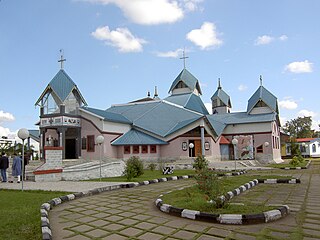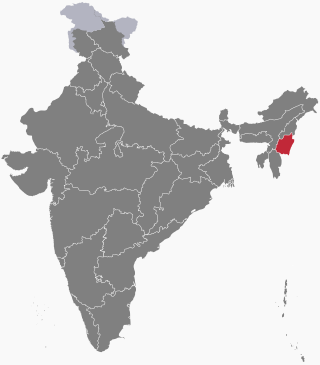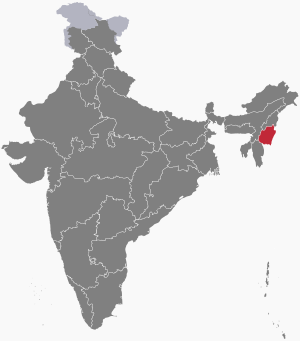
Manipur is a landlocked state in northeast India with Imphal as its capital. It borders Assam to the west, Mizoram to the south, and Nagaland to the north. It shares international borders with Myanmar, specifically the Sagaing Region to the east and Chin State to the southeast. Covering an area of 8,621 square miles, the state consists mostly of hilly terrain with the 700-square-mile Imphal Valley inhabited by the Meitei (Manipuri) community, historically a kingdom. Surrounding hills are home to Naga and Kuki-Zo communities, who speak Tibeto-Burman languages. The official language and lingua franca, Meitei (Manipuri), also belongs to the Tibeto-Burman family.

The Meitei people, also known as Meetei, Manipuri people, are a Tibeto-Burman ethnic group native to the Indian State of Manipur. They form the largest and dominant ethnic group of Manipur in Northeast India. They speak the Meitei language, one of the 22 official languages of the Republic of India and the sole official language of Government of Manipur. The Meiteis primarily settled in the Imphal Valley region in modern-day Manipur, though a sizeable population has settled in the other Indian states of Assam, Tripura, Nagaland, Meghalaya, and Mizoram. There is also a notable presence of Meiteis in the neighbouring countries of Myanmar and Bangladesh. The Meiteis represents about 53% of Manipur's population.
The Bombay riots were a series of riots that took place in Bombay, Maharashtra, between December 1992 and January 1993. An estimated 900 people, predominantly Muslims, were killed. The riots were mainly due to escalations of hostilities after large scale protests by Muslims in reaction to the 1992 Babri Masjid Demolition by Hindu Karsevaks in Ayodhya; and by Hindus in regards with the Ram Temple issue.

The Meitei Pangals, also known as Meitei Muslims or the Manipuri Muslims, are a group of Meitei Muslims. They live mainly in Manipur. The word Pangal simply means Muslim in the Meitei language. Various historical sources have different dates for when Islam first entered Manipur. However, the date all sources seem to confirm as definitive is 1606 AD. The origin of the Pangal community is equally varied.

Chinglen Nongdrenkhomba (1788–1834), also known as Raja Gambhir Singh, was a ruler of the Manipur Kingdom.
Religious violence in India includes acts of violence by followers of one religious group against followers and institutions of another religious group, often in the form of rioting. Religious violence in India has generally involved Hindus and Muslims.

Christianity is the second largest religion in Manipur, a state in Northeast India, according to 2011 census. The tribal communities, Kukis and Nagas are overwhelmingly Christian, along with their kindred communities in the neighbouring states. The dominant Meitei community has only small numbers of Christians, but Meitei groups claim Christianity to be a threat. At the start of the 2023–2024 Manipur violence, Meitei mobs burned down 200–300 churches in the Imphal Valley belonging to all communities, and prohibited pastors from rebuilding them.

In July 2012, violence in the Indian state of Assam broke out with riots between indigenous Bodos and Bengali Muslims in the Bodoland region of North East, India. The first incident was reported to have taken place on 20 July 2012. At least 108 people died and over 400,000 people were displaced into 270 relief camps, after being displaced from almost 400 villages. Eleven people have been reported missing.

The 1985 Gujarat riots began in February 1985 and lasted till August, in the Indian state of Gujarat. Most of the rioting occurred in the city of Ahmedabad; some other cities, including the state capital of Gandhinagar, were also affected. Between 220 and 275 people were killed in the violence, while several thousands of others were injured, and tens of thousands were displaced. The riots also caused widespread property damage.

The clashes between the Jat and Muslim communities in Muzaffarnagar district of Uttar Pradesh, India. By date 17 September, the curfew was lifted from all riot affected areas and the army was also withdrawn.
There have been several instances of religious violence against Muslims since the partition of India in 1947, frequently in the form of violent attacks on Muslims by Hindu nationalist mobs that form a pattern of sporadic sectarian violence between the Hindu and Muslim communities. Over 10,000 people have been killed in Hindu-Muslim communal violence since 1950 in 6,933 instances of communal violence between 1954 and 1982.

The Insurgency in Manipur is an ongoing armed conflict between India and a number of separatist rebel groups, taking place in the state of Manipur. The Insurgency in Manipur is part of the wider Insurgency in Northeast India; it displays elements of a national liberation war as well as an ethnic conflict.

Jiribam District is a district at the western periphery state of Manipur, India. It borders the Cachar district of Assam on the west, and serves as the western gateway for Manipur. Formerly a subdivision of the Imphal East district, it was made an independent district in December 2016.

The 2020 Delhi riots, or North East Delhi riots, were multiple waves of bloodshed, property destruction, and rioting in North East Delhi, beginning on 23 February 2020 and brought about chiefly by Hindu mobs attacking Muslims. Of the 53 people killed, two-thirds were Muslims who were shot, slashed with repeated blows, or set on fire. The dead also included over a dozen Hindus, who were shot or assaulted. More than a week after the violence had ended, hundreds of wounded were languishing in inadequately staffed medical facilities and corpses were being found in open drains. By mid-March many Muslims had remained missing.
On 3 May 2023, ethnic violence erupted in India's north-eastern state of Manipur between the Meitei people, a majority that lives in the Imphal Valley, and the Kuki-Zo tribal community from the surrounding hills. According to government figures, as of 3 May 2024, 221 people have been killed in the violence and 60,000 people have been displaced. Earlier figures also mentioned over 1,000 injured, and 32 missing. 4,786 houses were burnt and 386 religious structures were vandalised, including temples and churches. Unofficial figures are higher.

Arambai Tenggol is a Meitei activist organisation in the Indian state of Manipur founded by Manipur's titular king and Rajya Sabha member Leishemba Sanajaoba, who also remains as its chairman. Arambai Tenggol has been described as a radical organisation, or as a radicalised armed militia. It is also a revivalist organisation that aims to reestablish the pre-Hindu, native Sanamahi religion among the Meiteis. It enjoys the patronage of Sanajaoba as well as the chief minister N. Biren Singh. During the 2023–2024 Manipur violence, members of the Kuki-Zo community blamed it for having carried out deadly attacks against them. In January 2024, the organisation demonstrated its influence by summoning all the elected Meitei legislators of the state for a meeting to deliberate on the defence of Meiteis in the prevailing conflict.

The Meitei people, also called Manipuri people, is one of the minority ethnic groups in Assam. They are referred to as Mekhlee, Mekhelee, Meckley, Monipuri, Monipuriya, Magalu, Mogolu, Moglie, Moglai, among many other names dedicated to them by the other people of Assam. Meiteis call Assam as "Tekhao" or "Tekhau" or "Tekhaw". In October 2020 their population was estimated 168,127 with its population, the Meitei tribe is a fairly large ethnic minority in Assam and Meitei culture can be found in everywhere places.
The Coordinating Committee on Manipur Integrity (COCOMI) is a joint body of Meitei civil society organisations in the Indian state of Manipur. It came into being in 2019 in the wake of the peace talks between the Indian government and Naga rebel groups, as the latter sought autonomy and integration of the Naga-inhabited areas of Manipur into a Greater Nagaland. COCOMI campaigns for maintaining the "territorial integrity" of Manipur, which was a princely state under the British Raj and became part of the Indian Union upon India's independence.
Torbung Bangla is a village in the geographical precincts of Churachandpur district in Manipur, India. It is populated mostly by Meitei people who regard themselves as being part of Bishnupur district. The village was originally called Boljang, with an educational sericulture farm established here. At present, the village is a site of contestation between the majority Kuki-Zo people of the Churachandpur district and the Meitei people that dominate the state of Manipur. During the 2023–2024 Manipur violence, the village was almost entirely burnt down by Kuki mobs.













